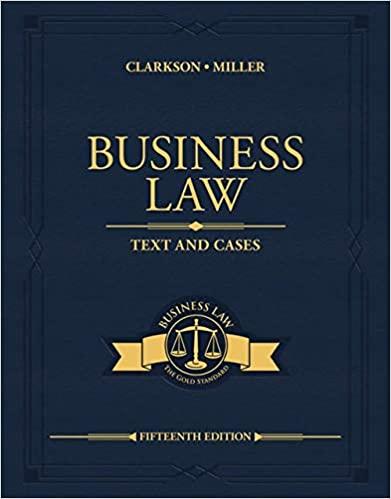Question
Please answer each (all- 25) question - True or False. 1. The word verdict does not mean to speak the truth. True or False 2.
Please answer each (all- 25) question - True or False.
1. The word verdict does not mean to speak the truth. True or False
2. An award of punitive damages is intended to compensate a tort victim for his or her injuries. True or False
3. Juries return verdicts; courts enter judgments. True or False
4. Contributory negligence is a legal doctrine that provides a plaintiff whose negligence contributed to cause his or her own injuries was not entitled to recover any damages from an alleged tortfeasor. True or False
5. Recovery of damages by a plaintiff for pain and suffering is not permitted in tort claims. True or False
6. At common law, when a plaintiff died as a result of injuries inflicted by a tortfeasor, his claim for damages died along with him. True or False
7. Liquidated damages are damages that can be identified and stated in a sum certain. True or False
8. A seller of a product makes an implied warranty of merchantability and fitness by offering the product for sale to the public. True or False
9. In a pure comparative fault jurisdiction, an "at fault" plaintiff may still recover damages even if the plaintiff's comparative fault is greater than the defendant's comparative fault. True or False
10. "Puffing", or exaggerating, in the context of the sale of goods (such as, a used car salesman saying "this is the best car you will ever buy"), is generally not actionable as constituting misrepresentation. True or False
11. The "One Free Bite" rule of tort law is a disputed doctrine that provides an owner of a domesticated animal is not liable to a person whom the animal bites unless the animal has already taken its one free bite first. True or False
12. Tort law is intended to protect a person from more than simply an injury to their physical body. True or False
13. For purposes of strict liability in tort, some courts have held that storing explosives and poisonous gasses are examples of abnormally dangerous activities. True or False
14. A person commits the tort of misrepresentation by knowingly making a false statement with the intention of inducing reliance on the misrepresentation by the plaintiff to the plaintiff's detriment. True or False
15. Common law is the body of law that is built up over time through past court decisions and is based on community standards, customs and experience. True or False
16. Medical expenses and lost wages are not examples of special damages. True or False
17. The majority and dissenting opinions in thePalsgrafcase reflect the disagreement between Judges Cardozo and Andrews on the issues of forseeability and proximate cause. True or False
18. Notice is the touchstone for the liability of an owner or possessor of land in a tort claim for damages for injuries resulting from a dangerous condition of property. True or False
19. A "Section 1983" lawsuit is a suit against a public officer or a public entity to collect damages for violation of a constitutional right guaranteed under the Bill of Rights. True or False
20. Both state legislatures and the US Congress have passed legislation that expands the rights of citizens and consumers to bring lawsuits that would otherwise not be permitted under the common law of torts. True or False
21. Product liability can be based on any one of three theories: negligence, breach of warranty, or strict product liability. True or False
22. Plaintiffs who are public figures must prove actual malice in order to recover in a suit for defamation. True or False
23. Generally, if an employee/agent of an employer/principal is engaged in an "independent frolic" at the time the employee commits a tort, the employer will not be liable to the tort victim. True or False
24. The collateral source rule is a rule of evidence that limits introduction into evidence at trial of some other source of benefits to the plaintiff, such as health insurance, or of liability insurance available to the defendant, because such evidence is irrelevant to the right of the plaintiff to collect damages from the defendant. True or False
25. All an employer has to do to avoid liability for torts committed by an employee is to give the title to that employee of an independent contractor. True or False
Step by Step Solution
There are 3 Steps involved in it
Step: 1

Get Instant Access to Expert-Tailored Solutions
See step-by-step solutions with expert insights and AI powered tools for academic success
Step: 2

Step: 3

Ace Your Homework with AI
Get the answers you need in no time with our AI-driven, step-by-step assistance
Get Started


